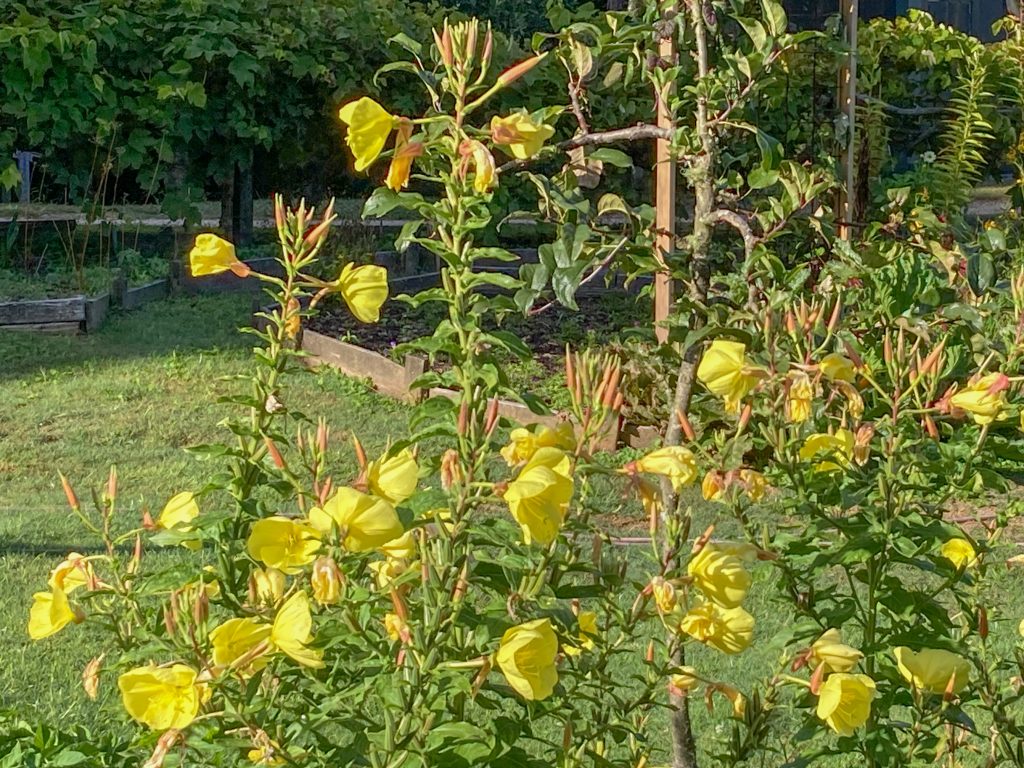
As I sit here, still jet lagged from our trip to New Zealand (I know, I know, I’m not REALLY complaining), I’m encouraged by the speed with which the snow is melting and the little green shoots are poking up through the ground. Spring is coming late to Santa Fe this year, but that’s ok. We NEED the moisture we’re getting from frequent snows and I can wait. Well, actually, I’m not very good at waiting, especially when I know something delicious is on the way!
One of my favorite new recipes last year was Spring Green Fritters with Evening Primrose Root. I’d have made it more often if the biggest wildfire ever recorded in the state of New Mexico hadn’t shut us out of the forest for the entire growing season. In anticipation of what’s to come (fingers crossed!) and to accompany the above-mentioned recipe, I thought a little background on evening primrose might be appreciated.
Oenothera biennis is the most widely distributed species of Oenothera in the U.S. and also one of the tastiest, at least one of the tastiest I’ve tasted. (I freely admit I haven’t tried them all.) The roots, leaves, flowers, and seeds of evening primrose are all edible, but only the roots are really worth harvesting, IMHO. The flowers are mostly decorative, with a mild, sweet flavor. Think salad or garnish. The leaves are ok, but nothing to write home about. They can fill out a stir-fry or fritatta. The flower stalks can be peeled and eaten raw or cooked, before the flowers open. The seeds of evening primrose are edible, and some people appreciate their medicinal properties. I don’t bother with them because I’m all about the food, and the seeds have no appreciable flavor. Go for the roots.

Some foragers say that evening primrose root has a strong peppery flavor, but I disagree. Maybe those foragers harvested the root from an unusually peppery population, maybe we have very different taste buds, or maybe they harvested out of season. Evening primrose roots are best harvested in fall of their first year or early spring of their second year, before the tall stem begins to grow. I find the flavor to be mild and appealing, with just the slightest hint of black pepper.
One friend reported that eating evening primrose root raw caused an itchy feeling in the back of the throat. So don’t eat it raw! It doesn’t taste great that way, anyway; the raw root can be fibrous and tough. Ah, but roasted, boiled, or mashed? That, my friends is an entirely different story. I mean, you wouldn’t eat a raw potato, would you?
In New Zealand the evening primrose was in full bloom and I discovered a lush group of them in the garden at Awaroa Lodge (aka paradise on earth). If you don’t have evening primrose in your garden, here’s what to look for:

- First year growth of evening primrose is a basal rosette of foliage.
- It’s often found in large colonies, in full sun .
- It’s asiest to spot in summer when the flower stalks stand one – six feet tall.

- Parts of the plant may be flushed with red at different times of year.
- Leaves are lance-shaped, two – seven inches long, with a prominent white midrib. They may be toothed or have wavy margins.
- Second year growth includes a hairy stem that produces large, four-petalled, yellow flowers, approximately two inches in diameter.
- Foliage along the flower stalk is arranged alternately.

- The tall, dried stalks of evening primrose often remain standing over winter. Use them to locate first year rosettes.
This post goes out to Rosie, the gardener at Awaroa.
I tried evening primrose root for the 1st time this evening. I sautéed it in butter. Delicious!! Even my husband liked it (he not as eager to try new or wild foods).
I’ve heard it described as similar to horseradish (which my husband does not like).
I’m eager for the Meadow Mushrooms to pop up. I plan to make a sauté combining Evening Primrose, Meadow Mushrooms, & green onions from the garden.
The 1st bite I tried was very mild except for a peppery bite at the end. Cooked it didn’t have that. Absolutely delicious!